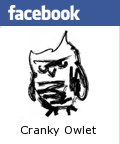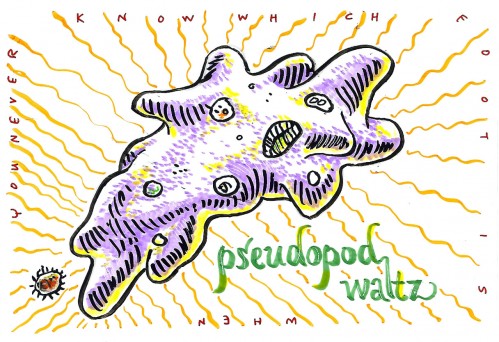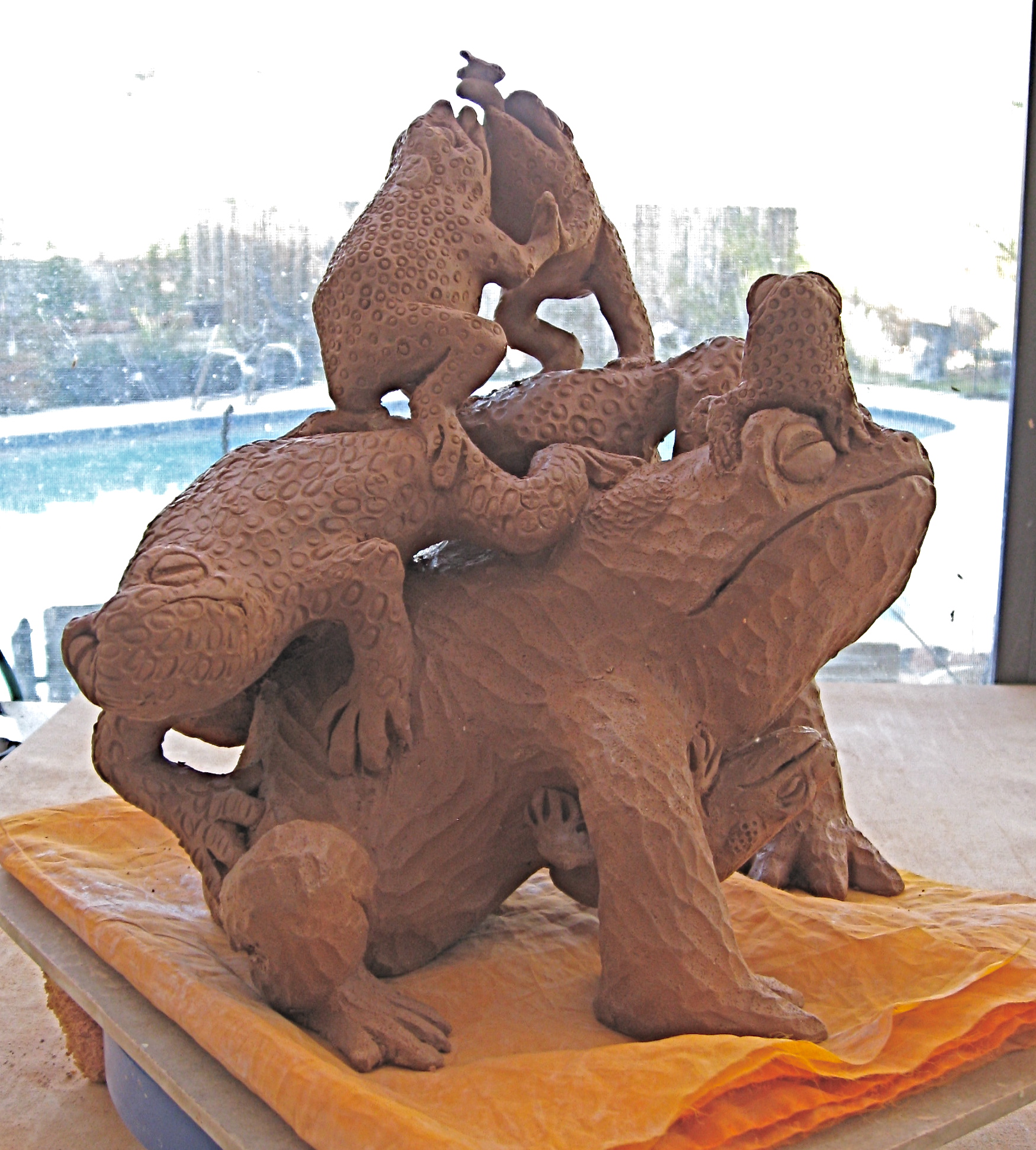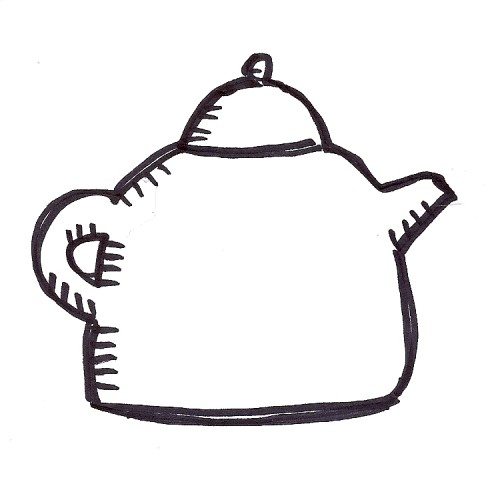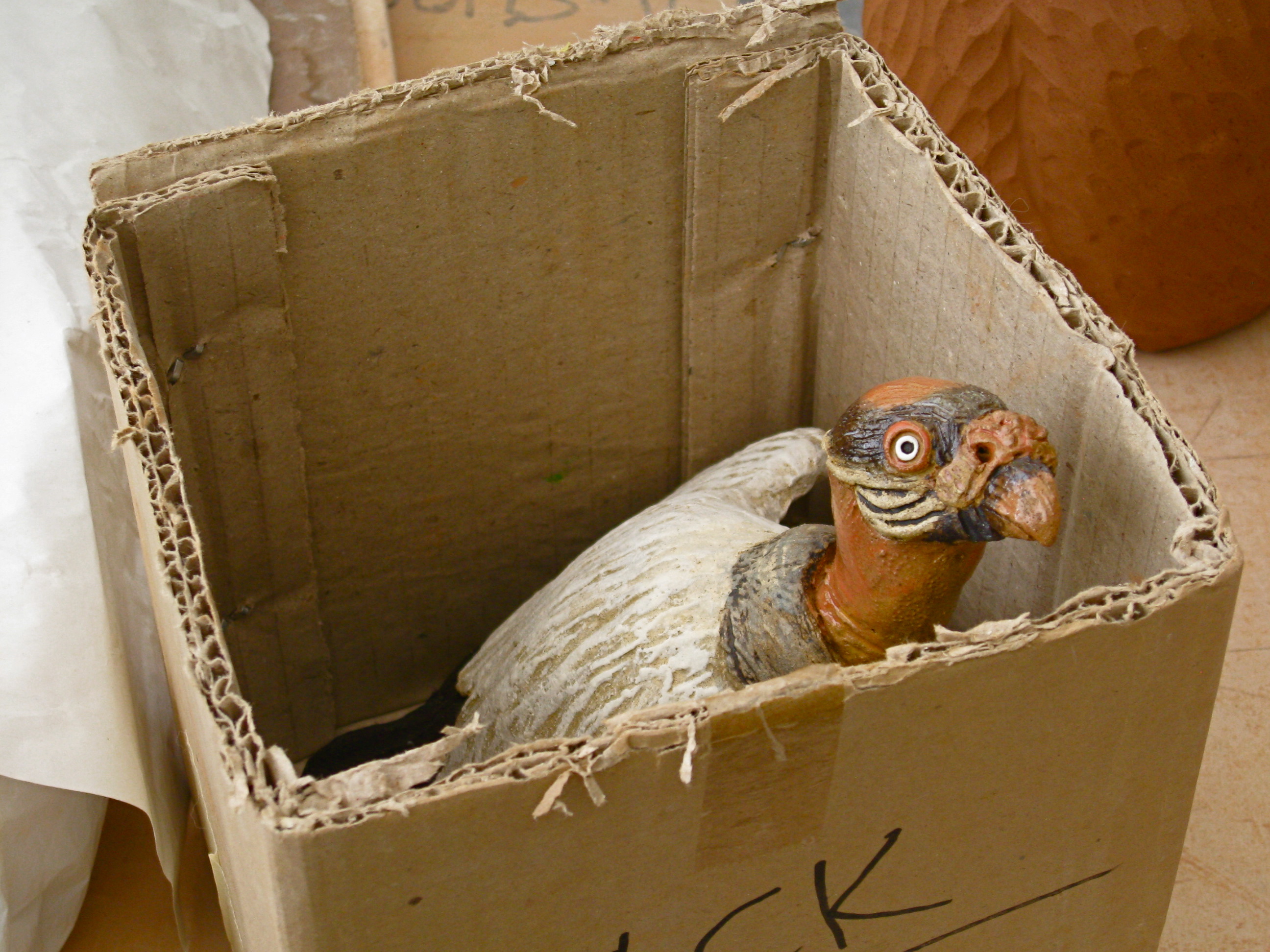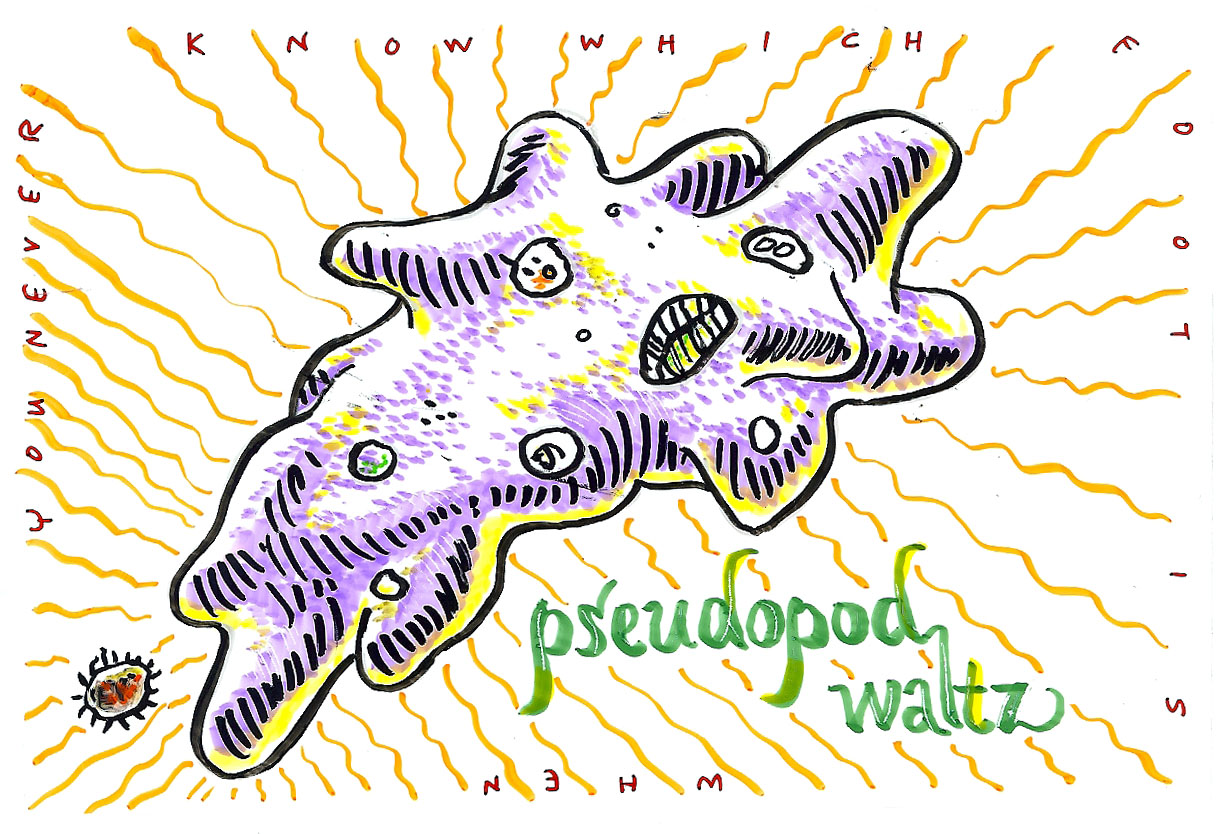From the San Diego Bird Festival
Late post (Sunday 8 March 2009):
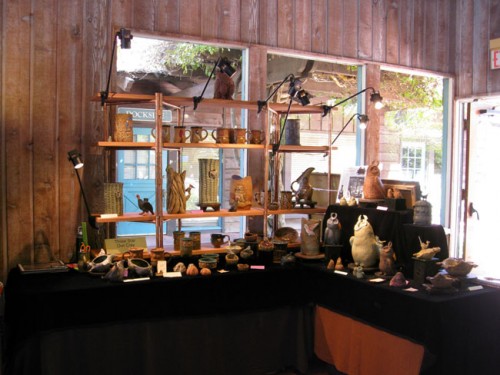 Hello from San Diego, where today is the last day of the San Diego Audubon Bird Festival. Things have been busy here, and I haven’t had a chance to post until now. The Festival is at the Marina Conference Center right on Mission Bay — here’s a shot of the Three Star Owl booth. It’s nice to be in a room with windows and a view. So many facilities are completely interior and have things like accordion walls with scotch tape holding up a leftover honeycomb wedding bell that was too high for the cleanup crew to reach. This room is wood-panelled and bright, and looks out onto a marina. Nice!
Hello from San Diego, where today is the last day of the San Diego Audubon Bird Festival. Things have been busy here, and I haven’t had a chance to post until now. The Festival is at the Marina Conference Center right on Mission Bay — here’s a shot of the Three Star Owl booth. It’s nice to be in a room with windows and a view. So many facilities are completely interior and have things like accordion walls with scotch tape holding up a leftover honeycomb wedding bell that was too high for the cleanup crew to reach. This room is wood-panelled and bright, and looks out onto a marina. Nice!
E was able to come along and help, which is a treat because then each of us had an opportunity to go on a field trip. He’s doing a San Diego River outing as I write this, and yesterday I joined a pelagic trip out to the Islas Coronadas, a small grouping of islands in Mexican water within sight of San Diego. The room is still swaying a bit this morning, although by Pacific standards the seas weren’t rough.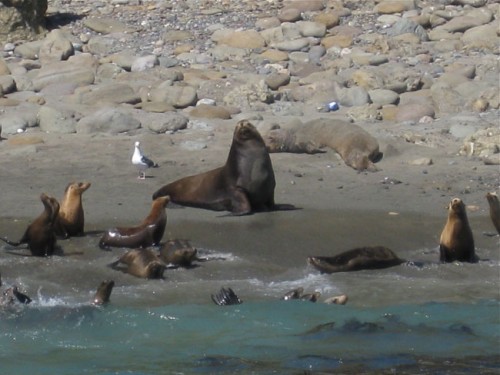 My little camera doesn’t do distant birds well, so I don’t have a picture of what was for me the highlight of the trip, several pairs of small alcids (a type of sea bird) called Xantus’s murrelets, which, although we had great looks, would never be more than little black and white blobs bobbing on the waves in my photos. There were many excellent sea birds to be seen, but also mammals, including close looks at Gray Whales migrating north, and four species of dolphins: Risso’s, Common, Pacific white-sided and Bottlenosed, who larked under the bows, close enough so that we could hear them exhale when they surfaced. Above is a photo of something my camera can handle — a California sea lion beach-master with his harem.
My little camera doesn’t do distant birds well, so I don’t have a picture of what was for me the highlight of the trip, several pairs of small alcids (a type of sea bird) called Xantus’s murrelets, which, although we had great looks, would never be more than little black and white blobs bobbing on the waves in my photos. There were many excellent sea birds to be seen, but also mammals, including close looks at Gray Whales migrating north, and four species of dolphins: Risso’s, Common, Pacific white-sided and Bottlenosed, who larked under the bows, close enough so that we could hear them exhale when they surfaced. Above is a photo of something my camera can handle — a California sea lion beach-master with his harem.
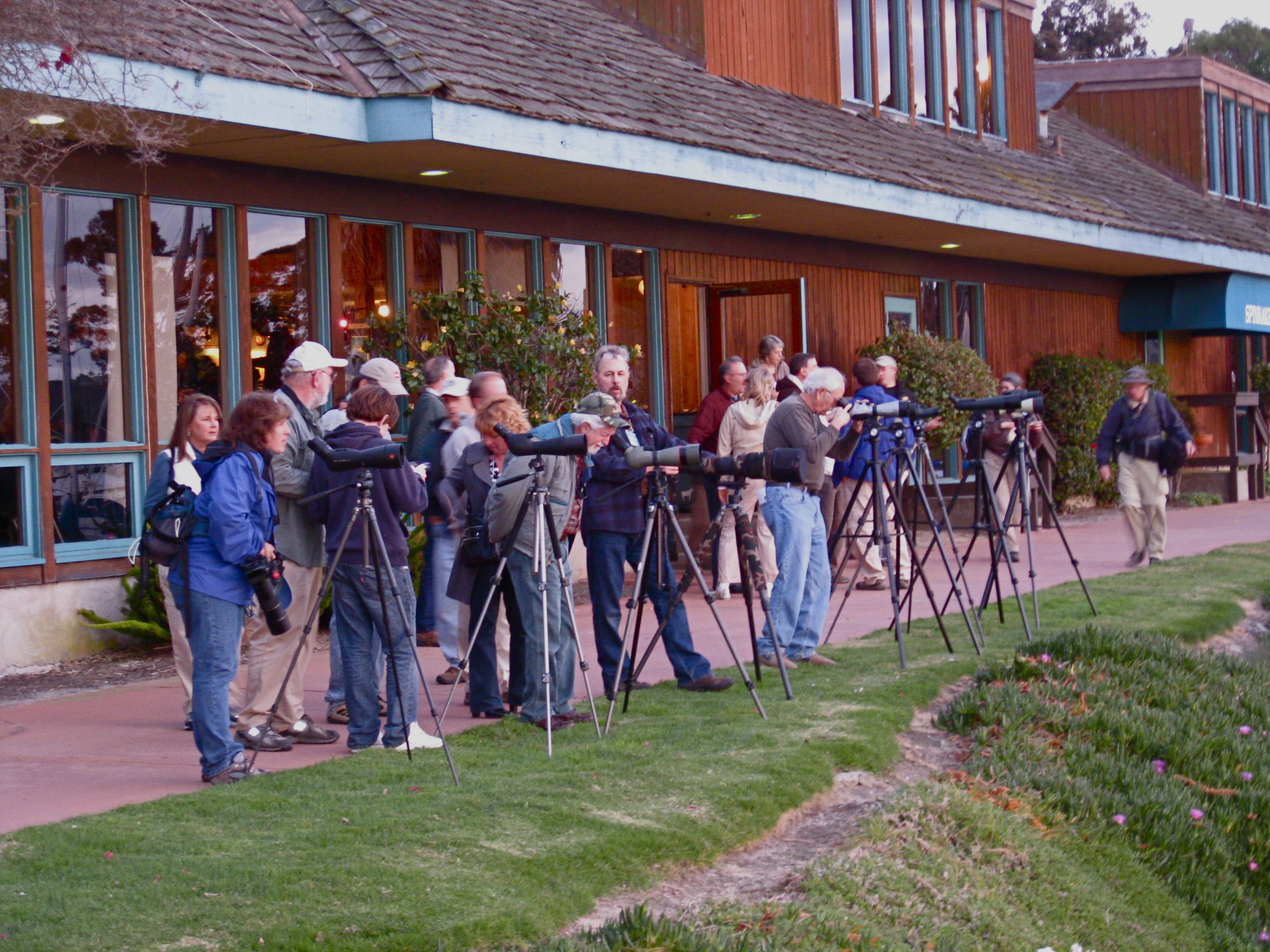 In case you’re a non-birder, and don’t know what birders do at bird festivals, the main events are organized field trips to local hot-spots, led by experts, to look at birds. The exhibit room has exhibitors like state Fish & Game people or the American Birding Association giving out info, and vendors with bird and nature related supplies, photos, and art for sale (like Three Star Owl). Optics manufacturers have reps there, so that attendees can check out scopes and binox. Occasionally impromptu viewings break out, such as when a Merlin was spotted atop a mast in the Marina, and the line of demo scopes was commandeered for viewing. Pretty heady times!
In case you’re a non-birder, and don’t know what birders do at bird festivals, the main events are organized field trips to local hot-spots, led by experts, to look at birds. The exhibit room has exhibitors like state Fish & Game people or the American Birding Association giving out info, and vendors with bird and nature related supplies, photos, and art for sale (like Three Star Owl). Optics manufacturers have reps there, so that attendees can check out scopes and binox. Occasionally impromptu viewings break out, such as when a Merlin was spotted atop a mast in the Marina, and the line of demo scopes was commandeered for viewing. Pretty heady times!
Stay tuned: on the way home E and I stopped at the Mud Volcano site on the Salton Sea for a spot of sampling and marvelling at gloopy mud-blorping “gryphons”.
San Diego Audubon Bird Festival
This is the week of the San Diego Birding Festival at the Marina Conference Center right on Mission Bay. The keynote speaker will be David Allen Sibley, the artist and author of the Sibley field guides to the birds of North America,  which are considered some of the top field guides available. Many of the field trips are full, but there are spaces left and last-mintue cancellations, plus there’s lots to do at the Festival besides field trips: lectures, workshops, local self-guided birding, and shopping — come by Three Star Owl and say Hi!
which are considered some of the top field guides available. Many of the field trips are full, but there are spaces left and last-mintue cancellations, plus there’s lots to do at the Festival besides field trips: lectures, workshops, local self-guided birding, and shopping — come by Three Star Owl and say Hi!
I’ve got the usual assortment of owls, non-owl birds (!), and reptiles, plus I’ve included some coastal and California species for the occasion, like the Eared Grebe hanging tile pictured here. Also, this show marks the West Coast debut of “rat-dogs” — generic mammal-form pieces that look like they might bite, or communicate a disease. Take one home if you dare.
For more details, see here and here.
Stacked toad teapot effigy and the mathematics of artistic license
The Stacked Toad Teapot Effigy is alive and well, so far.
After languishing at the back of a shelf in the studio for many weeks wrapped in damp paper towels and layers and layers of plastic film, the Stacked Toad Teapot Effigy has finally been fully sculpted and is drying, awaiting further surface treatment (terra sigillata and slips) and firings. Between the last episode and now, I’ve added a new under-toad hanging upside down off of the main toad’s belly, and refined the detail of the piece, textured all the toads, and cleaned up the crannies.
If you’re having a tough time seeing why it’s a teapot effigy (and it is Toadlier than Teapotly), here’s a visual aid:
Remember the issue of pentadactyly in the studio and the fact that unlike the majority of tetrapods toads have only 4 digits on their front pair of limbs? Here are the final numbers: Potential (actual biological) toe count: 7 (# of toads) x 18 (# of toes each toad has) = 126!! One hundred and twenty six toes on a piece that’s less than 12″ tall! Yikes! Does it have 126 toad toes? No: Actual toe count = 108: This is known as artistic license which can also be expressed as Biological digit defecit: 14.3%. A close call! — it’s generally considered that greater than 15% and it becomes Grossly Inaccurate (over 25% and it’s just Wrong). There are, however, the requisite number of paratoid glands — 14 — in case you were wondering. And, the flying insect “finial” has no toes at all — too tiny.
Three Star Owl is Guest Blogger on Birdchick.com!
Great news! Sharon Stiteler of Birdchick.com fame ran a contest for guest-bloggers while she’s out of the country, and Three Star Owl is her selection for Friday’s guest post! Regular Three Star Owl readers will recognize the entry as a post from this web journal, Vertical Napping Bark, which is one of my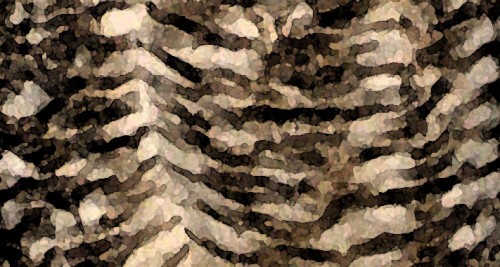 favorites because of the lucky shot of the Great horned owl with downy chick in a snag, demonstrating the beauty of Owly Invisibility very well.
favorites because of the lucky shot of the Great horned owl with downy chick in a snag, demonstrating the beauty of Owly Invisibility very well.
[The image to the right is a digitally-altered photo of the breast feather vermiculation (= Latin for “wormy pattern”) that makes Great horned owls so invisible.]
If you’ve found your way to Three Star Owl from the Birdchick site, Welcome (Cranky Owlet says Hmph!), and take a look around: there’s lots of birdy art in the Gallery and Shop, and posts at the Journal on a variety of topics like birds, clay art, natural history and more! Make yourself at home, and come back any time.
(Cranky Owlet says Hmph!), and take a look around: there’s lots of birdy art in the Gallery and Shop, and posts at the Journal on a variety of topics like birds, clay art, natural history and more! Make yourself at home, and come back any time.
Thanks, Sharon, and have a great time in Guatemala!
Oh, and in my excitement, I forgot to mention that Swarovski Optik, makers of excellent binox and scopes, and beeooteeful crystal, is helping Sharon sponsor the contest.
Increments: Color me vulture, finally
Here are the exciting final steps of Jack’s King Vulture. (Previous increments can be viewed and read about here.)
This first photo, Increment 3, is a close-up of what the piece looks like after it’s been bisqued (fired the first time) and then glazed. Pretty crappy looking, isn’t it? That’s because glaze is a chalky-looking liquid suspension made of clay, mineral pigments and oxides, a flux or glassy component to create various levels of gloss after melting, plus water. If Pepto Bismol came in a lot of different icky-pale flavors, they would look like glazes. Because of this, glazing a piece you’ve already spent hours on can be an act of faith, and once the raw glazes are on, it’s often hard to escape the feeling that now you’ve gone and ruined it, which sometimes you have. Fortunately the more you glaze, the better able you are to predict what the chalky colors will look like after firing, so the more you trust the materials and the process (=faith, for a potter). It’s only after the final firing that the glaze colors take on any kind of brightness and glassy quality. Here is Increment 4, Jack’s finished King Vulture, Sarcoramphus papa, photographed in the wilds of Scottsdale:
Pretty crappy looking, isn’t it? That’s because glaze is a chalky-looking liquid suspension made of clay, mineral pigments and oxides, a flux or glassy component to create various levels of gloss after melting, plus water. If Pepto Bismol came in a lot of different icky-pale flavors, they would look like glazes. Because of this, glazing a piece you’ve already spent hours on can be an act of faith, and once the raw glazes are on, it’s often hard to escape the feeling that now you’ve gone and ruined it, which sometimes you have. Fortunately the more you glaze, the better able you are to predict what the chalky colors will look like after firing, so the more you trust the materials and the process (=faith, for a potter). It’s only after the final firing that the glaze colors take on any kind of brightness and glassy quality. Here is Increment 4, Jack’s finished King Vulture, Sarcoramphus papa, photographed in the wilds of Scottsdale: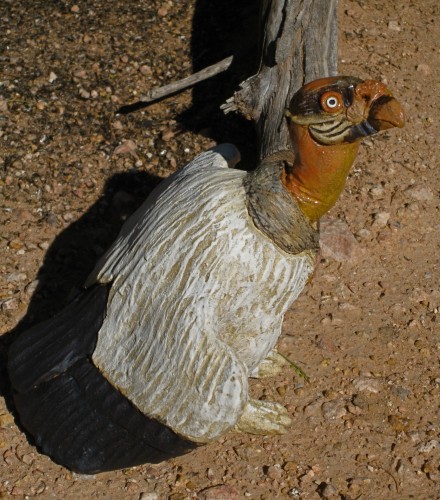
Check out the pale eye, it’s not a mistake: the King Vulture’s iris is white, which to our eyes looks pretty weird. In Mayan glyphs King Vultures are readily identifiable not only by the fleshy knob or caruncle atop their strong, hooked beak, but also by the bold concentric depiction of the staring white eye. Below is a plate from Animal Figures in the Maya Codices by A.M. Tozzer and G.M. Allen (1910) that shows a selection of Mayan King Vulture glyphs. Of course, I’m not an expert, but Tozzer and Allen report that the King Vulture represents Cib, the 13th day of the month. And, on an ornithological note, figure 4 in the plate below shows a King Vulture entwining necks with an Ocellated turkey, the turkey of the Maya, which puts our Wild Turkey of North America to shame in terms of colorful plumage and warty wattly facial skin, which is saying something. I photographed the Ocellated turkey below at Chan Chich in Belize, where they inhabit the immediate area along with King Vultures, like the one in a previous post who tried to hide behind a leaf.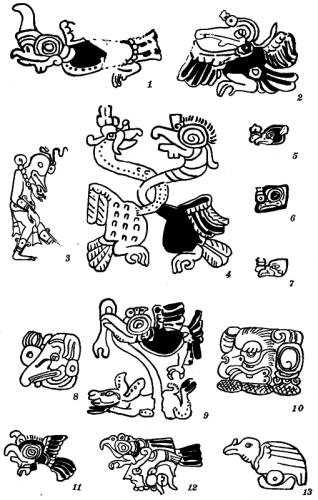
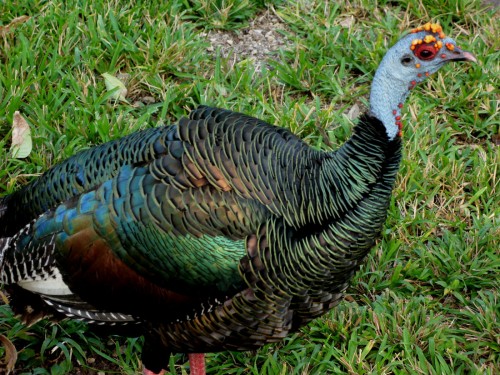 By the way, if you live in the Phoenix area, there are two King Vultures on display in a large aviary at the Phoenix Zoo. You could drop in any time to visit them. E and I just did, on Valentine’s Day. I guess we missed Cib by one day!
By the way, if you live in the Phoenix area, there are two King Vultures on display in a large aviary at the Phoenix Zoo. You could drop in any time to visit them. E and I just did, on Valentine’s Day. I guess we missed Cib by one day!
P.S. — Cardinals do not have yellow bills
Here’s a red subject for Valentine’s Weekend:
In Phoenix there are cardinals.
Everybody knows the football Cardinals, aka “the Redbirds”, who nearly won the Superbowl recently. But fewer people, even native Arizonans, know that we also have real Northern cardinals, (Cardinalis cardinalis), aka cardenal comun. You can’t imagine how surprised some people are when they find out the familiar peaky-headed, conical-billed redster lives in the desert. I can’t explain this, except that so many folks who live here are originally from the leafy Midwest and Eastern US where the bird is an iconic resident of yards, gardens, and woodlands. The classic Redbird is so common in the East that it’s the state bird of no fewer than seven states: Illinois, Indiana, Kentucky, North Carolina, Ohio, Virginia and West Virginia, more than any other bird (just edging out the Western meadowlark with six and the Mockingbird with five). But the spiny, dry desert? Nope: in many people’s minds, the cardinal doesn’t figure in this land of Cactus wrens, buzzards, and roadrunners. Without going off on a much of a rant (see “PS” below for a short one), I blame popular culture — especially cartoons — which are such a pervasive influence on what we “know” about the world around us that they can override actual observation.
For example, this is a typical conversation: Friend: Hey, what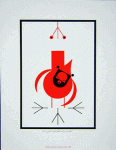 kind of a bird did I see at the Desert Botanical Garden yesterday? It looked exactly like a cardinal, but I know it couldn’t be, because they don’t live here! Me: Was it all red with a black mask and a point on its head, a little smaller than a robin? (We don’t frequently see robins here, but it’s a meaningful comparison for most non-birders because everyone knows robins). Friend: Yes. Me: Then it was a cardinal. Friend: What do they do, stock them there or something? etc…
kind of a bird did I see at the Desert Botanical Garden yesterday? It looked exactly like a cardinal, but I know it couldn’t be, because they don’t live here! Me: Was it all red with a black mask and a point on its head, a little smaller than a robin? (We don’t frequently see robins here, but it’s a meaningful comparison for most non-birders because everyone knows robins). Friend: Yes. Me: Then it was a cardinal. Friend: What do they do, stock them there or something? etc…
But cardinals do live here, and they are more or less native. 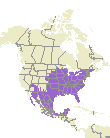 By that I mean according to the Cornell Lab of Ornithology whose range map this is, Northern cardinals were “first sighted” in south-central Arizona in the 1870s. (Were they here already, and some white guy just noticed them and told some official ornithology guy back east? I don’t know.) But their range is expanding northward, and now they’re found along the Colorado River, among other western locations, and there are even insular populations in Los Angeles and Honolulu, although somebody put them there, they didn’t wing themselves over. Our desert cardinals like desert scrub and riparian areas, especially if there is water convenient. They are found in some neighborhoods in Phoenix, but not all. We see them occasionally in our yard, but the only evidence I’ve personally seen of breeding sadly involved a female cardinal feeding a cowbird chick.
By that I mean according to the Cornell Lab of Ornithology whose range map this is, Northern cardinals were “first sighted” in south-central Arizona in the 1870s. (Were they here already, and some white guy just noticed them and told some official ornithology guy back east? I don’t know.) But their range is expanding northward, and now they’re found along the Colorado River, among other western locations, and there are even insular populations in Los Angeles and Honolulu, although somebody put them there, they didn’t wing themselves over. Our desert cardinals like desert scrub and riparian areas, especially if there is water convenient. They are found in some neighborhoods in Phoenix, but not all. We see them occasionally in our yard, but the only evidence I’ve personally seen of breeding sadly involved a female cardinal feeding a cowbird chick.
Nothing looks redder than a male cardinal against greenery, and the cardinals of the Sonoran desert are no exception; in fact, they may look even redder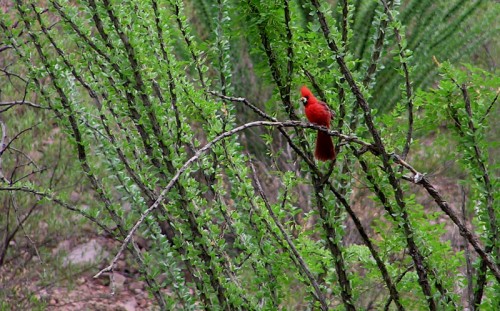 . There could be a couple of reasons for this. Our subspecies, Cardenalis cardenalis superbus is the largest of the subspecies, and its crest isn’t significantly less red than its breast, and its black facial mask is slightly less extensive than that in other subspecies. All of this adds up to More Redder. Above is a picture of a Cardinal in front of a fully leafed-out Ocotillo. He has a grub in its beak which he flew away with, which means he was feeding young or a female at the nest. Otherwise he would have gulped it down himself.
. There could be a couple of reasons for this. Our subspecies, Cardenalis cardenalis superbus is the largest of the subspecies, and its crest isn’t significantly less red than its breast, and its black facial mask is slightly less extensive than that in other subspecies. All of this adds up to More Redder. Above is a picture of a Cardinal in front of a fully leafed-out Ocotillo. He has a grub in its beak which he flew away with, which means he was feeding young or a female at the nest. Otherwise he would have gulped it down himself.
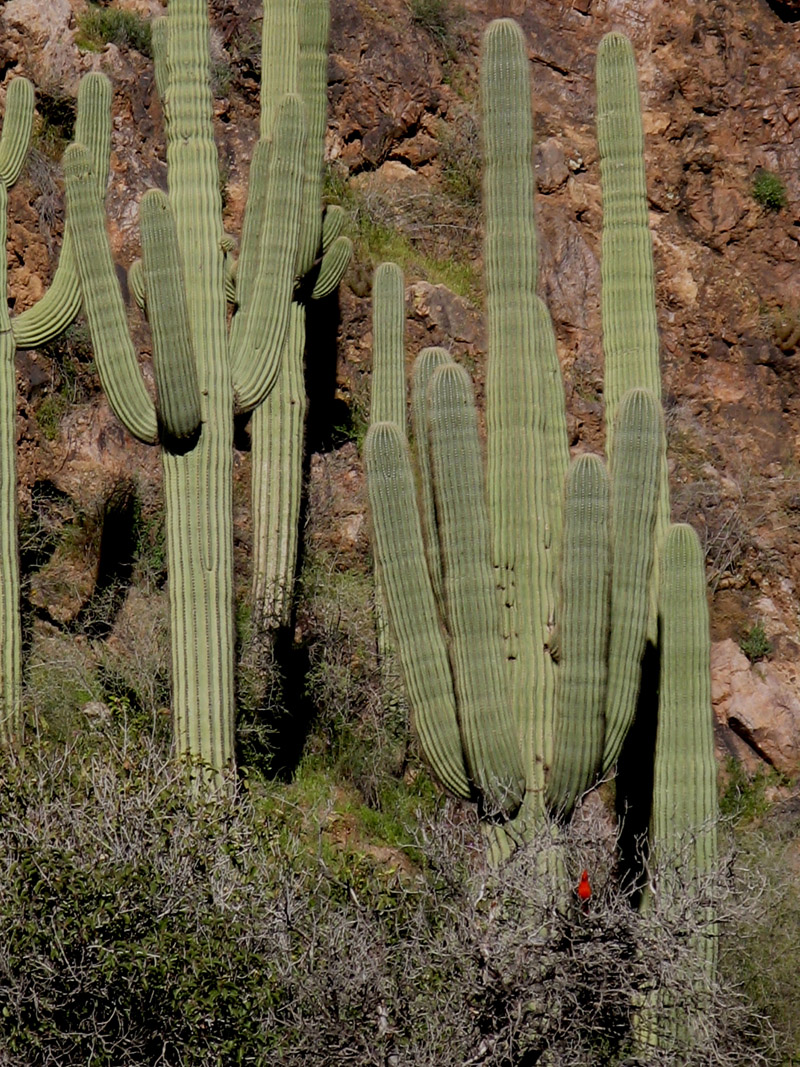 So, in the interest in promoting the broader image of cardinals in all of our minds, the photo to the left is a replacement iconography to “cardinal in the snow”: a male cardinal in the Sonoran Desert. This one, along with about six others heard or seen within a half-mile of the trailhead, was singing out his nuptial qualifications loud and clear on the Peralta Trail in the Superstition Mountains east of Phoenix last March. Feel free to click on the photo to see a larger image.
So, in the interest in promoting the broader image of cardinals in all of our minds, the photo to the left is a replacement iconography to “cardinal in the snow”: a male cardinal in the Sonoran Desert. This one, along with about six others heard or seen within a half-mile of the trailhead, was singing out his nuptial qualifications loud and clear on the Peralta Trail in the Superstition Mountains east of Phoenix last March. Feel free to click on the photo to see a larger image.
Photos: #1, male Northern cardinal at Boyce Thompson Arboretum, Superior, AZ (A. Shock). #2, male Northern cardinal and Ocotillo, Rancho Esmeralda, Sonora, Mexico (A. Shock). #3, male Northern cardinal and saguaros, Superstition Mtns, Pinal County, AZ (A. Shock).
P.S. — Please note that none of the real cardinals pictured in this post has a yellow bill.
Rant warning (this makes me see red). The prevalent and imaginary species “yellow-billed cardinal” has been a pet-peeve of mine since we lived in St. Louis. Both the baseball Cardinals and the football Cardinals (who were still in St. Louis when we were) use jazzy redbird logos that show Cardinals with yellow bills. The baseball Cardinals’ mascot, Fredbird, has a yellow bill, too. The artist in me understands that the second spot of color makes for livelier graphics. Unfortunately, I think it’s also another example of pop culture infesting our knowledge of the real world: robins have yellow bills, duckies have yellow bills, therefore cartoon crows have yellow bills, and therefore all bird’s bills are yellow. And it’s not just the two Cardinals teams — start looking at images of birds in advertising and popular graphics: most birds have yellow bills. Having made the complaint, I’m not saying sports logos should all be biological illustration (although the Baltimore Oriole is pretty realistic). But for me the redbird logo loses some “cardinal-ness” with the bill color inaccuracy — it is shifted away from cardinal and toward generic bird, which is less interesting. But I empathize with an artist who has to make a cardinal look tough, and I do admire the result, from a graphics point of view. Here’s the Arizona Cardinals logo, and I have no idea if I’m infringing on copyright to post it here; I hope not.
Unfortunately, I think it’s also another example of pop culture infesting our knowledge of the real world: robins have yellow bills, duckies have yellow bills, therefore cartoon crows have yellow bills, and therefore all bird’s bills are yellow. And it’s not just the two Cardinals teams — start looking at images of birds in advertising and popular graphics: most birds have yellow bills. Having made the complaint, I’m not saying sports logos should all be biological illustration (although the Baltimore Oriole is pretty realistic). But for me the redbird logo loses some “cardinal-ness” with the bill color inaccuracy — it is shifted away from cardinal and toward generic bird, which is less interesting. But I empathize with an artist who has to make a cardinal look tough, and I do admire the result, from a graphics point of view. Here’s the Arizona Cardinals logo, and I have no idea if I’m infringing on copyright to post it here; I hope not.
However, I don’t think there’s any hope of biological integrity for Fredbird. Sorry. I have never seen a Cardinal with yellow gloves on. And what’s with the primary-colored primaries? A real cardinal isn’t colorful enough? It’s just not right…
Bonus Bird with yellow bill absolutely free:
Now, if you want to see a real desert-dwelling cardinal-like bird with a yellow bill, check out the fabulous Pyrrhuloxia at an excellent post from Firefly Forest, which I can’t improve on. Except to add, here’s a Pyrrhuloxia portrait magnet, from 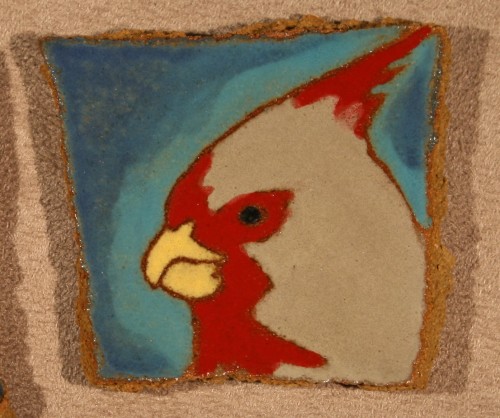 Three Star Owl:
Three Star Owl:
